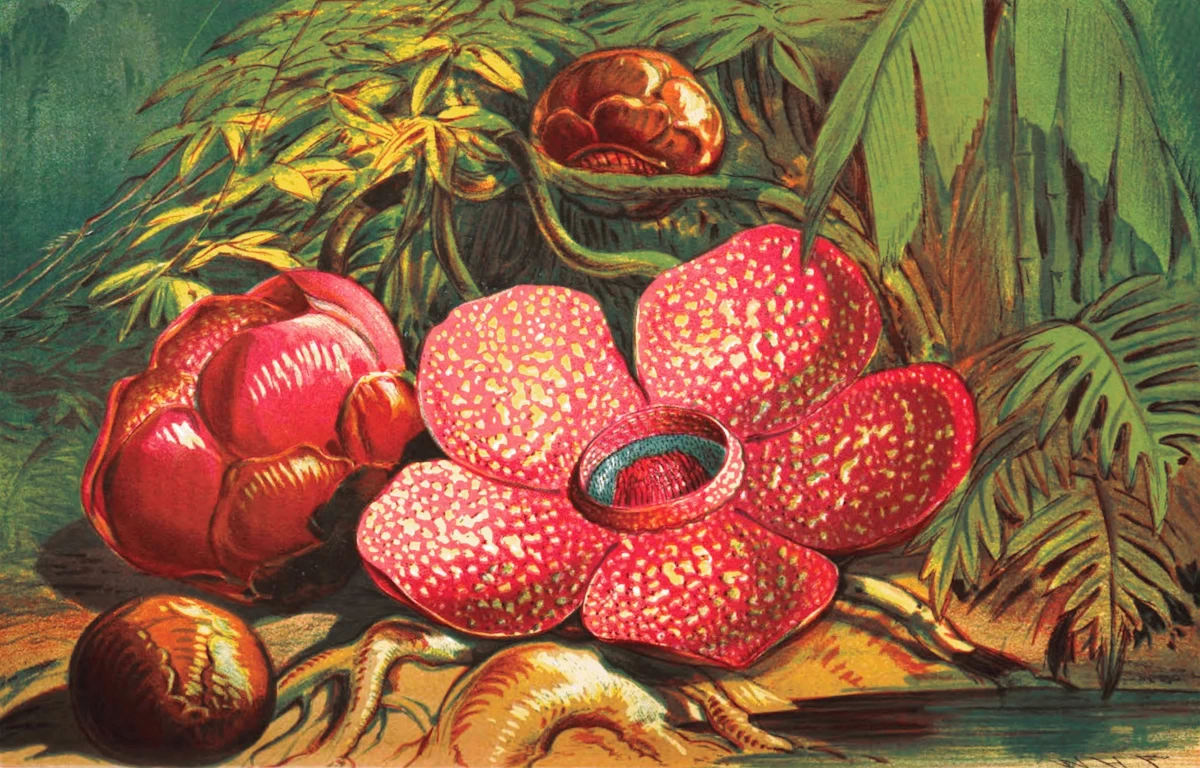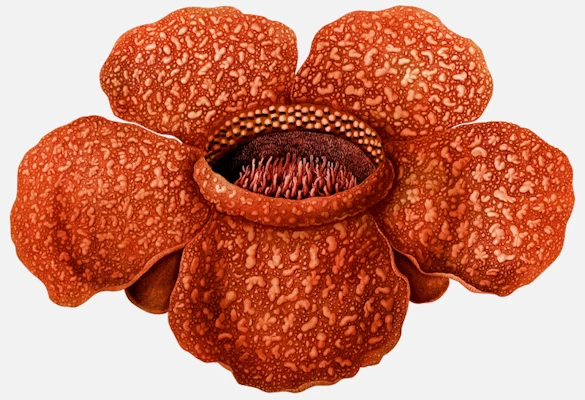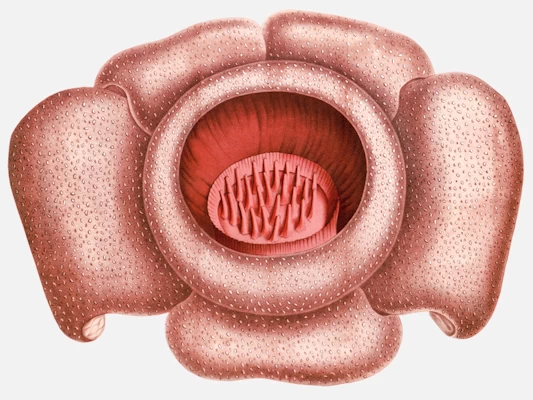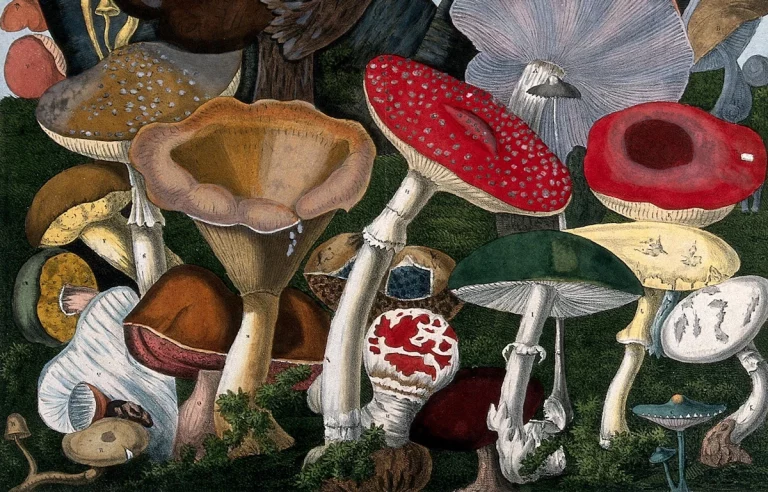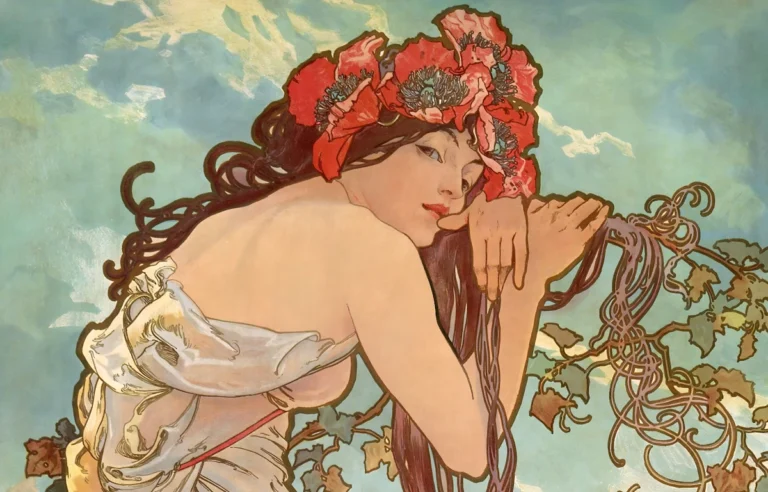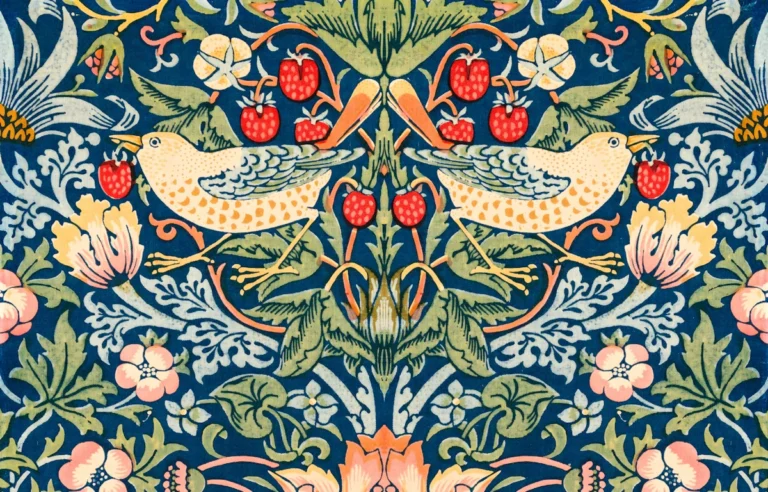The Fascinating Discovery of the Corpse Flower, Rafflesia
The story of the Rafflesia, better known as the corpse flower (and for good reason—it’s basically the world’s worst air freshener), is a wild ride through the world of botanical exploration. Imagine trekking through the rainforests of Southeast Asia and stumbling upon a flower so huge, it could double as a tire for a small car. And did I mention it smells like rotting meat? Yes, this parasitic plant, lurking in places like Malaysia and Indonesia, holds the title for the largest single flower in the world. But beyond its startling appearance and gag-worthy scent, the discovery of Rafflesia involves a fascinating story of lost notes, botanical adventures, and unexpected twists.
Although Rafflesia got its big moment in the spotlight in the early 19th century, it was actually first discovered over 20 years earlier by a French physician and naturalist named Louis Auguste Deschamps. This hidden gem of the plant world not only revealed a bizarre species but also opened the door to learning more about the quirky relationships between plants and their environments. So, hold your breath (literally) as we dig into the corpse flower’s path to fame!
Early Botanical Exploration in Southeast Asia
In the late 18th and early 19th centuries, botanical exploration was the “in” thing for scientists and explorers. Picture it like a race to discover the next big thing, but instead of gold or hidden treasure, they were after plants, bugs, and animals. The European powers of the time, eager to flex their colonial muscles, sent out their best naturalists to distant lands to catalog new species, often hoping to find something useful—or at least something cool to brag about. Southeast Asia, with its jaw-dropping biodiversity, was a prime destination. If you were a scientist back then, it was the ultimate field trip.
Botanists in this era weren’t just looking for pretty flowers, either. Many plants had practical uses: medicinal, culinary, or even industrial. In fact, one of the driving forces behind botanical expeditions was the hope of discovering plants that could be cultivated for profit. Spices like nutmeg, cloves, and pepper were already huge moneymakers. Who knows? Maybe the corpse flower would have found a use—although with that smell, it would probably work better as a pest deterrent than anything you’d want to bottle up and sell.

Faguet (1867)
Louis Auguste Deschamps and the First Encounter with Rafflesia
Before Sir Stamford Raffles ever laid eyes on the corpse flower, Louis Auguste Deschamps had already found it during his exploration of Java in 1797. Deschamps was a bit of a Renaissance man—both a physician and a naturalist—which means he had a keen eye for unusual plants, and boy, did Rafflesia deliver. As part of a French scientific expedition, Deschamps was scouring the jungles for interesting plants when he came across what he described as a “giant, foul-smelling flower.” If that’s not a red flag to back away slowly, I don’t know what is.
But Deschamps, being the diligent scientist that he was, took detailed notes, measured the flower, and carefully documented its repulsive scent. What’s impressive about Deschamps is that he recognized that this wasn’t just your average jungle bloom. He had stumbled upon something truly remarkable. However, thanks to the Napoleonic Wars and a touch of bad luck, much of his research never saw the light of day. When the British intercepted his ship on the way back to France, they confiscated most of his notes and specimens. Some people lose luggage; Deschamps lost one of the biggest botanical discoveries of his time.
To make matters worse, much of Deschamps’ discovery was buried under the political chaos of the time. His encounter with Rafflesia didn’t get the recognition it deserved until much later, when historians finally pieced together his lost notes. Imagine being so close to scientific fame, only to have history sweep it away with one well-timed ship interception!
Sir Stamford Raffles and the (Re)Discovery of Rafflesia
While Deschamps’ initial encounter with Rafflesia was left out of the spotlight, the credit for its discovery ended up going to Sir Stamford Raffles and Dr. Joseph Arnold. Raffles, who is better known for founding Singapore, wasn’t just a bigwig colonial administrator. He was also a passionate naturalist, with a genuine interest in expanding the world’s understanding of plants and animals. In 1818, when Raffles organized an expedition into the wilds of Sumatra, he wasn’t just doing it for kicks. He was serious about uncovering the natural treasures hidden in the dense rainforest—and that’s where the corpse flower enters the scene.
Along for the ride was Dr. Joseph Arnold, a surgeon and naturalist who played an instrumental role in rediscovering Rafflesia. Arnold was no stranger to the weird and wonderful creatures of the natural world, but when a local guide named Lebbai led him to the gigantic flower near the Manna River, even he was floored. Here was a flower that seemed more suited to an alien planet than a tropical rainforest. With its fleshy, mottled petals and the unmistakable stench of death, this flower was unlike anything the world had seen before. And yes, the smell had a purpose—luring flies that mistook it for a decomposing animal, which helped with pollination. You’ve got to admit, nature has some creative ways of getting the job done.
What’s even more fascinating is that Arnold and Raffles’ expedition wasn’t just a botanical joyride. Raffles was thinking big picture—he wanted to document the region’s natural resources to understand not only its scientific importance but also its potential for economic gain. Sadly, Arnold didn’t live to enjoy the fruits of his discovery, as he died shortly after from a fever. But his contribution was immortalized when the flower was named Rafflesia arnoldii, in honor of both Raffles and Arnold.
The Rediscovery of Rafflesia Arnoldii
When Dr. Arnold rediscovered Rafflesia, he didn’t just stumble upon an oddball flower. He found the largest known flower in the world. At nearly three feet in diameter, this bloom was a giant by any standard. You wouldn’t need a magnifying glass to spot this one! Arnold, ever the diligent scientist, immediately got to work, taking detailed notes, sketches, and specimens to document the flower.
One interesting bit of trivia about Rafflesia is how rare it is to actually see the flower in bloom. It spends most of its life as an unremarkable brown bud, kind of like a deflated basketball. It can take months for the bud to develop, and when it finally blooms, it’s only for a few short days. After that, the flower rapidly decays into a slimy, black mess. Talk about a dramatic entrance and exit! It’s no wonder that finding a blooming Rafflesia in the wild feels like winning the lottery for botanists.
The plant was named Rafflesia arnoldii to commemorate both Raffles’ efforts in organizing the expedition and Arnold’s role in documenting the rediscovery. This collaboration between the two men, along with their passion for natural history, helped solidify the flower’s place in botanical fame. And while they may have gotten the credit, let’s not forget that Deschamps was the original discoverer—though history wasn’t too kind to him on that front.
The Strange and Stinky Biology of Rafflesia
The Rafflesia isn’t just famous for being big; it’s also one of the weirdest plants in existence. First off, it’s a parasitic plant, which means it can’t live on its own. Instead, it mooches off another plant, a vine called Tetrastigma, for all its nutrients. It’s like the botanical equivalent of a couch potato that never gets up to make its own meals. You won’t find any leaves, stems, or roots on Rafflesia because, well, it doesn’t need them. The majority of the plant hides inside the tissues of its host vine, only showing its face (or rather, its flower) when it’s ready to bloom.
What’s especially fascinating is how the flower tricks flies into helping with pollination. By emitting a scent that’s uncannily similar to rotting flesh, Rafflesia attracts carrion flies and beetles that mistake it for a decaying animal. These insects are drawn in by the promise of a potential feast, only to find themselves duped by a plant. As they buzz around the flower, they inadvertently pick up pollen and carry it to other Rafflesia blooms, helping the plant reproduce. It’s a clever trick, albeit a bit morbid.
One more fun fact about Rafflesia’s biology: its life cycle is a lesson in patience. The buds, which resemble little cabbages, can take months to mature. Once the flower blooms, it has just a few days to attract pollinators before it begins to wilt and decay. The timing is so precise that botanists and tourists who want to see Rafflesia in bloom have to plan their trips carefully. Blink, and you might miss it.
The Legacy and Vulnerability of Rafflesia
For all its fame, Rafflesia is a bit of a diva—it’s both rare and vulnerable. Its dependency on the Tetrastigma vine and its limited range in the rainforests of Southeast Asia make it highly susceptible to habitat destruction. As more and more rainforests are cleared for agriculture, logging, and development, the places where Rafflesia can grow are shrinking fast. It’s not just the flower that’s at risk, though. The host vine is also endangered, meaning that without Tetrastigma, the corpse flower has no way of surviving.
Conservation efforts are underway to protect Rafflesia and its host vine, but saving a flower that smells like rotting meat isn’t exactly easy. There’s even some debate about whether Rafflesia can be cultivated outside its natural environment, given its highly specialized relationship with its host plant. Still, scientists and conservationists are working hard to ensure that future generations will have the chance to marvel at this botanical oddity—nose plugs recommended, of course.
Conclusion
The saga of Rafflesia is a testament to the strange and wonderful world of botany. From Deschamps’ overlooked discovery to Arnold and Raffles’ triumphant rediscovery, the corpse flower has captivated the imaginations of naturalists and plant enthusiasts for over two centuries. Its bizarre biology and unforgettable stench have cemented its place as one of nature’s most peculiar plants. Yet, as fascinating as it is, the future of Rafflesia remains uncertain. As we work to protect the rainforests it calls home, we can only hope that this one-of-a-kind flower will continue to surprise and delight those who seek it out—even if they have to hold their breath to do so.


